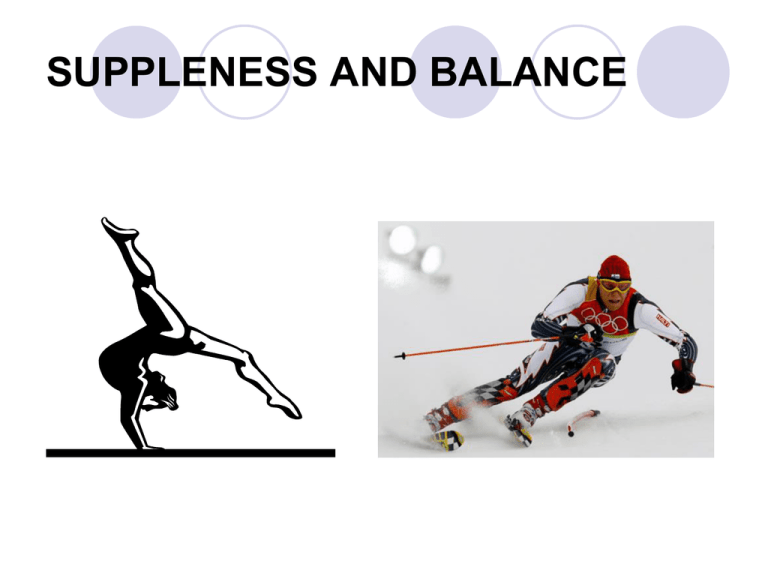Suppleness & Balance
advertisement

SUPPLENESS AND BALANCE Flexibility Flexibility is the range of movement across a joint. Most activities require flexibility. Having good flexibility reduces the chances of straining or pulling muscles. The Effects of Flexibility on Performance In many activities flexibility is required; for example, when hurdling in athletics and when swimming back crawl. The hurdler needs hip flexibility in particular, as this will help the hurdler clear the hurdles with minimum effort and maximum efficiency. The swimmer needs back flexibility to help when pushing off, and arm and shoulder flexibility to produce a wide range of movement. The wider the range of movement the more effective the stroke. Two types of flexibility There are two types of flexibility: static and dynamic flexibility: Static flexibility is necessary when you are holding a balance e.g. in gymnastics. Dynamic flexibility is a fast action that is not held for any length of time. An example would be a volley in football Training to Improve Flexibility Exercises to maintain and improve flexibility are usually either static or dynamic. To improve static flexibility you would hold a stretch for at least 20 seconds. To improve dynamic flexibility you would use ballistic stretching (stretching on the move) exercises (spry session). Monitoring the Effectiveness of Flexibility Training It is important to monitor training: • To avoid over-training • To see if your training is working One way to see if your training is working is to re-test yourself (Sit and Reach Test) after so many weeks of training. Appropriate training methods will have a positive effect on performance levels specific to the activity Benefits of Improved Flexibility • Improved Physical Performance and Decreased Risk of Injury A flexible joint has the ability to move through a greater range of motion and requires less energy to do so, while greatly decreasing your risk of injury. • Improved Skilled Performance • Improved Muscle Coordination • Increased Blood and Nutrients to Tissues This allows greater elasticity of surrounding tissues and increases performance. Balance Balance is the ability to retain the centre of gravity over your base of support. There are two types of balances: 1) Static balances 2) Dynamic balances Centre of Gravity Centre of gravity is to do with stability. i. The heavier you are, the more stable you will be ii. To be balanced your centre of gravity should be inside your base iii.A low position with a wide base is more balanced Centre of Gravity




